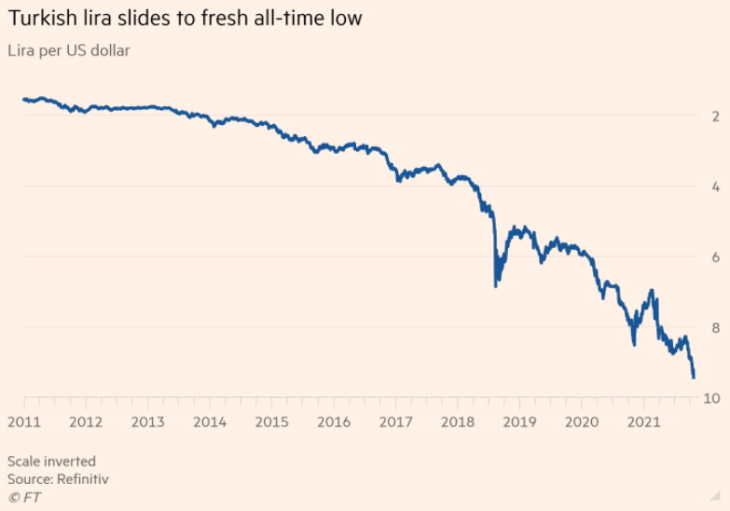Turkey’s President Erdogan is probably the world’s most famous proponent of NeoFisherism, the view that low interest rate policies are disinflationary and high interest rates policies are inflationary. Academic NeoFisherians, however, would presumably be horrified by the approach he has taken to implement this idea. This FT article is from a month ago:
Turkey’s central bank has defied warnings from the business world and opposition parties by slashing its main interest rate despite rising inflation and an ailing currency. . . .
The Turkish president, whose view that high interest rates lead to inflation runs counter to established economic orthodoxy, has increasingly meddled in monetary policy as he consolidates his control over the Turkish state. He has pushed for rate cuts even at the cost of soaring inflation and turmoil in the financial markets.

So how is the new policy working out? A more recent FT article shows that the lira has now plunged even lower:
The Turkish lira suffered a historic retreat after President Recep Tayyip Erdogan praised a recent interest rate cut and declared that his country was fighting an “economic war of independence”.
The currency, which is down more than 40 per cent against the dollar this year, plunged as much as 15 per cent on Tuesday — a drop that eclipsed even Turkey’s currency crisis of 2018 — and broke through the symbolic threshold of 13 to the dollar after Erdogan used a combative speech to expound his vision for the country’s economy.
This doesn’t mean that NeoFisherism is wrong (although I do believe it is wrong). After all, despite these rate cuts Turkey still has both high nominal interest rates and high inflation, the exact correlation predicted by NeoFisherians. Erdogan’s mistake was in not understanding that interest rates can fall due to either an easy money policy or a tight money policy. He made the mistake of trying to cut rates with an easy money policy, and now Turkey is paying the price with high inflation.
In other words, he confused correlation with causation.


READER COMMENTS
dlr
Nov 24 2021 at 6:13pm
I think you are being too easy on neofisherism here. If you reduce it to a mere observation of a correlation, there isn’t anything neo about it. Rather, proponents have specifically claimed that a ZIRP central bank like the Fed needs to proactively raise interest rates to increase inflation. do they conceive of some highly unorthodox “loosening raise” regime-change level announcement? nope. Instead they just wave the “equilibrium selection” wand and boom, thousands of real time event studies of market reactions to rate surprises disappear.
Erdogan is an excellent natural experiment. So many CB loosening errors are too conflated with fiscal weakness to provide useful tests. But Turkey had a relatively tame situation, at least until it voluntary wiped out the capital buffer of its banks by smashing the Lira, and it has embarked on something that is more neofisherian than even neofisherians have suggested. He is outright saying that he is going to lower inflation by lowering rates! he tried this in 2018 and slammed on the brakes with a surprise rate increase of 600 pts (and the lira climbed). now he’s tripling down, at least until he doesn’t.
Scott Sumner
Nov 25 2021 at 2:10am
“I think you are being too easy on neofisherism here.”
I did say I think the theory is wrong.
Market Fiscalist
Nov 24 2021 at 10:07pm
If Erdogan was able to convince the markets that his reduction in interest rates was a clear signal of his government’s intention to reduce the rate of NGDP growth then his policy would very likely succeed.
rsm
Nov 24 2021 at 11:23pm
Isn’t this really about currency trading and TRY shorts? If Turkey fully indexes like Israel, can’t it ignore high inflation as Israel did for decades?
Scott Sumner
Nov 25 2021 at 2:08am
Inflation is costly even with indexation, although certainly less costly. But why do it? What’s the benefit?
Cove77
Nov 25 2021 at 8:40am
Scott,
Not unrelated. Would love to hear your thoughts on Japan and BOJ’s inability to create inflation. Thanks
https://www.economist.com/finance-and-economics/2021/11/20/the-case-of-the-curiously-quiescent-inflation-rate
Scott Sumner
Nov 25 2021 at 1:03pm
It’s a mistake to focus on the supposed reluctance of firms to raise prices. Given the very slow rate of NGDP growth, you would not expect any inflation in Japan. They need a more expansionary monetary policy. A good first step would be to switch to level targeting.
Rajat
Nov 25 2021 at 7:00pm
I wonder if Steve Williamson will respond, given this effort in 2018?
Scott Sumner
Nov 26 2021 at 12:00am
The problem with NeoFisherism is that its proponents seem to talk about interest rates as a cause, not an effect. Of course, Keynesians make the same mistake.
It means nothing to say that the Turkish central bank reduced interest rates, unless it is first made clear whether they did so with an expansionary or a contractionary monetary policy. I’m surprised how many economists seem confused on that point.
David S
Nov 26 2021 at 6:11pm
Thank you for this post, Scott (and for your follow-up post on Japan–Cove77 beat me to the question on that topic).
But how do things “end” for Turkey? Does it become like Argentina? Or Venezuela? If I were a Turkish citizen I would be afraid to hold lira or to undertake investments inside the country. If I were a foreign investor or speculator I would be looking for avenues of attack–or complete retreat.
Scott Sumner
Nov 27 2021 at 3:43pm
I can’t predict that, but my hunch is that it ends up closer to Argentina than Venezuela. Things aren’t that bad in Turkey.
Comments are closed.